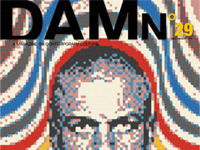
by Lyle Rexer
It seems somewhat phenomenal that this particular flower has known such prestige, and over such a long expanse of time. A major business pretty much from the word ‘go’, the ground upon which the much-cherished tulip grows is a perfectly manipulated patch of earth. And it is this that German photographer Julian Faulhaber has chosen to capture, precisely illustrating this severely systematised, dispassionate chunk of landscape. The photographs are shot from the air, where it is frighteningly apparent that the harshly patterned landscape parallels the systematic nature of the industry that feeds it. Harsh.
Talk about Tulip mania! Over the course of four weeks (April/May), some 9 million tulips are harvested in two major parts of the Netherlands, Lisse and Noordoostpolder. And although the value of that harvest does not even come close to the price tag put on bulbs during the rage that took place back in 1637, when certain varieties commanded upwards of 10 times the annual income of a skilled craftsman, tulips represent a major share of the Dutch economy. It may not be a million hectares of wheat in Kansas, but with exports of more than two billion bulbs a year, it is agribusiness nonetheless.
The German photographer Julian Faulhaber, known for his antiseptic views of new, squeaky-clean architectural structures, from gas stations to chic restaurants, shot a bird’s eye view of the Noordoostpolder tulip fields for The New York Times. He found himself in a helicopter trying to steady a medium-format camera against the bumpy air currents, in order to capture the mathematical precision and impersonal beauty of systematised nature. From high up, where details blur and patterns predominate, the full impact of what he was shooting became clear. “I kept thinking of Edward Burtynsky’s pictures of oil fields,” he remarks “and how different they look from the ground. You can see this landscape as clearly part of an economic system”, he adds. “The rows of coloured flowers look like lines of product on a warehouse rack.”
Over-kill
The photos straddle a line between two distinct lineages of what we might call the cataloguing of contemporary catastrophe. On the one hand, there are projects such as Burtynsky’s early work, Andreas Gursky’s 99 Cent Store and Chris Jordan’s series ‘Running the Numbers’, in which he digitally depicts two million plastic bottles, among other mass produced items. All these works emphasise the vast scale and sheer repetitiveness of consumption, whether it be tyres, tulips, toilet paper or cell phones. A more riotous and even celebratory attitude prevails in Matthieu Borysevicz’s Learning from Hangzhou, with its pages and pages of Western-style department store mannequins, all virtually identical. On the other hand, there is Faulhaber’s decision to go vertical. From the air, Emmet Gowin, David Maisel, and Burtynsky, not to mention Werner Herzog, have all shown the impact of a man-altered landscape, “nature controlled, structured, and organised”, in Faulhaber’s words, and with some potentially apocalyptic implications.
Since 2008, EU laws have limited the types of pesticides Dutch tulip growers can use, but many remain legal and are applied in vast quantities because hybridisation has weakened the most desirable strains. The negative health effects are yet to be fully charted. The higher the altitude, however, the more visually stunning the view becomes, as with Maisel’s photos of polluted areas in the U.S. or Gowin’s moon-like images of nuclear test craters in Nevada. It might be interesting to calculate whether there is an actual ‘aesthetic altitude’ at which fear and loathing give way to delectation and wonder. In any case, it’s a height at which photographers thrive and in which human beings can’t survive.